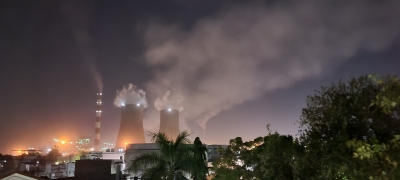Air Pollution: Far & wide impact of Chandrapur thermal power station
By IANS | Published: March 3, 2022 09:33 AM2022-03-03T09:33:03+5:302022-03-03T09:45:07+5:30
New Delhi, March 3 A study on the adverse impact of air pollution due to thermal power plant ...

Air Pollution: Far & wide impact of Chandrapur thermal power station
New Delhi, March 3 A study on the adverse impact of air pollution due to thermal power plant at Chandrapur in Maharashtra has estimated that there are several premature deaths happening not just around it but also very far from it.
The residents from Chandrapur and Nagpur are suffering significant health impacts from air pollution caused by the 2,920 MW coal powered Chandrapur Super Thermal Power Station (CSTPS) units in Chandrapur, 150 km from Nagpur.
A comprehensive air pollution health impact modelling conducted by the Centre for Research on Energy and Clean Air (CREA) a Health impacts of Chandrapur coal-based power plant, Maharashtra' estimates that the air pollution from the operation of units at Chandrapur Super Thermal Power Station (CSTPS) has resulted in 85 premature deaths in Chandrapur, 62 premature deaths in Nagpur, 45 in Yavatmal, 30 in Mumbai, 29 premature deaths in Pune and Nanded each during 2020 among several other cities in central India, which has been the worst impacted.
This independent assessment by CREA, which comes a little over a month after the National Green Tribunal (NGT) observed clear violations of air quality and other norms by the CSTPS in its recent order from January 2022. Among several other directions, the NGT had directed a health impact assessment study to assess the damage caused by the power station.
Findings showed that the effects of ambient air pollution coming from CSTPS resulted in respiratory among other health illnesses, which led to 34,000 sick leave days in Chandrapur and 30,000 days of absenteeism in Nagpur in 2020. "This shows how the productivity of people from these two cities is being compromised due to the impact of thermal power plant emissions," said Sunil Dahiya, an analyst at CREA and one of the authors of the report.
The operation at CSTPS resulted in the emission of high pollutant load: 4,724 tonnes of particulate matter emissions, 1,03,010 tons of sulphur dioxide (SO2), 28,417 tons of nitrogen dioxide (NO2) and 1,322 kgs of mercury in 2020.
The operation of the CSTPS in 2020 alone contributed to more than eight lakh sick leave days, approximately 1,900 asthma emergency room visits, of which over 800 were children, deaths of at least 1,300 people, and 1,800 preterm births across central India at 78 per cent PLF (Plant Load Factor the ratio of average power generated by the plant to the maximum power that could have been generated in a given time), according to the study.
The petitioner before the NGT in the Chandrapur matter, Madhusudan Roongta said, "While the older units at the station are beyond redemption to reduce pollution, retrofitting FGDs in newer units will significantly improve the ambient air quality of the region, leading to avoided sick leave days, fewer deaths and reduced hospital visits."
Prof Yogesh Dudhpachare, a member of Chandrapur Clean Air Action Group (CCAAG) said: "Despite the violations, there is no concrete action against CSTPS nor are they enforced to implement emission norms by Maharashtra Pollution Control Board."
Disclaimer: This post has been auto-published from an agency feed without any modifications to the text and has not been reviewed by an editor
Open in app